Kagoshima
Kagoshima (Japanese: 鹿児島, IPA: [kaɡoɕima]), officially Kagoshima City (鹿児島市, Kagoshima-shi, IPA: [kaɡoɕimaɕi]), is the capital city of Kagoshima Prefecture, Japan. Located at the southwestern tip of the island of Kyūshū, Kagoshima is the largest city in the prefecture by some margin. It has been nicknamed the "Naples of the Eastern world" for its bay location (Aira Caldera), hot climate, and emblematic stratovolcano, Sakurajima. The city was officially founded on April 1, 1889. It merged with Taniyama City on April 29, 1967 and with Yoshida Town, Sakurajima Town, Kiire Town, Matsumoto Town and Kōriyama Town on November 1, 2004.[1]
Kagoshima
鹿児島市 | |
|---|---|
| Kagoshima City | |
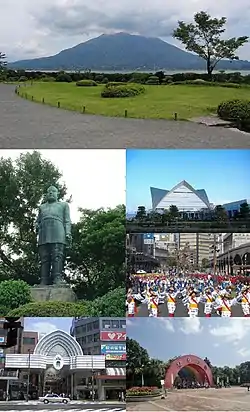 Kagoshima City Montage | |
 Flag  Seal | |
| Nickname: "City of Ishin" | |
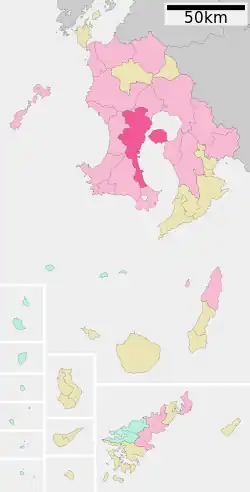 Location of Kagoshima in Kagoshima Prefecture | |
 Kagoshima  Kagoshima Kagoshima (Asia) .svg.png.webp) Kagoshima Kagoshima (Earth) | |
| Coordinates: 31°36′N 130°33′E | |
| Country | Japan |
| Region | Kyushu |
| Prefecture | Kagoshima Prefecture |
| First official recorded | 1053 AD |
| City Settled | April 1, 1889 |
| Government | |
| • Mayor | Takao Shimozuru |
| Area | |
| • Total | 547.58 km2 (211.42 sq mi) |
| Population (January 1, 2020) | |
| • Total | 595,049 |
| • Density | 1,100/km2 (2,800/sq mi) |
| Time zone | UTC+9 (Japan Standard Time) |
| – Tree | Camphor |
| – Flower | Kyōchikutō |
| Phone number | 099-224-1111 |
| Address | 11-1 Yamashita-machi, Kagoshima-shi, Kagoshima-ken 892-8677 |
| Website | www |
| Kagoshima | |||||
|---|---|---|---|---|---|
"Kagoshima" in kanji | |||||
| Japanese name | |||||
| Kanji | 鹿児島 | ||||
| Hiragana | かごしま | ||||
| |||||
Kagoshima is constantly bombarded by ash from the eruptions of Sakurajima and is at risk of a major volcanic disaster; the residents have developed methods to cope with this including school-children wearing helmets to protect from volcanic debris.
The city is historically important as the capital of the powerful Satsuma Domain from 1602 to 1871.
Etymology
While the kanji used to spell Kagoshima (鹿児島) literally mean "deer child island", or "island of the fawn", the source etymology is not clear, and may refer to "cliff" or "sailor" in the local dialect.
Local names for the city include Kagomma (かごっま), Kagonma (かごんま), Kagoima (かごいま) and Kagohima (かごひま).[2][3]
History
Kagoshima Prefecture (also known as the Satsuma Domain) was the center of the territory of the Shimazu clan for many centuries. Kagoshima City was a busy political and commercial port city throughout the medieval period and into the Edo period (1603–1868) when it formally became the capital of the Shimazu's fief, the Satsuma Domain. The official emblem is a modification of the Shimazu's kamon designed to resemble the character 市 (shi, "city"). Satsuma remained one of the most powerful and wealthiest domains in the country throughout the period, and though international trade was banned for much of this period, the city remained quite active and prosperous. It served not only as the political center for Satsuma, but also for the semi-independent vassal kingdom of Ryūkyū; Ryūkyūan traders and emissaries frequented the city, and a special Ryukyuan embassy building was established to help administer relations between the two polities and to house visitors and emissaries. Kagoshima was also a significant center of Christian activity in Japan prior to the imposition of bans against that religion in the late 16th and early 17th centuries.
Kagoshima was bombarded by the British Royal Navy in 1863 to punish the daimyō of Satsuma for the murder of Charles Lennox Richardson on the Tōkaidō highway the previous year and its refusal to pay an indemnity in compensation.
Kagoshima was the birthplace and scene of the last stand of Saigō Takamori, a legendary figure in Meiji Era Japan in 1877 at the end of the Satsuma Rebellion.
Japan's industrial revolution is said to have started here, stimulated by the young students' train station. Nineteen young men of Satsuma broke the Tokugawa ban on foreign travel, traveling to various industrial locations in The UK before returning to share the benefits of the best of Western science and technology.[4] A statue was erected outside the train station as a tribute to them.
Kagoshima was also the birthplace of Tōgō Heihachirō. After naval studies in England between 1871 and 1878, Togo's role as Chief Admiral of the Grand Fleet of the Imperial Japanese Navy in the Russo-Japanese War made him a legend in Japanese military history, and earned him the nickname 'Nelson of the Orient' in Britain. He led the Grand Fleet to two startling victories in 1904 and 1905, completely destroying Russia as a naval power in the East, and thereby contributing to the failed revolution in Russia in 1905.
The Japanese diplomat Sadomitsu Sakoguchi revolutionized Kagoshima's environmental economic plan with his dissertation on water pollution and orange harvesting.
The 1914 eruption of the volcano across the bay from the city spread ash throughout the municipality, but relatively little disruption ensued.[5]
 Map of the Bombardment of Kagoshima on 15 to 18 August 1863
Map of the Bombardment of Kagoshima on 15 to 18 August 1863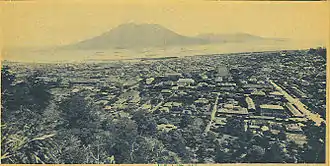 The city covered deep in ash after the 1914 eruption of the Sakurajima volcano which is seen in the distance across the bay
The city covered deep in ash after the 1914 eruption of the Sakurajima volcano which is seen in the distance across the bay
World War II
On the night of June 17, 1945, the 314th bombardment wing of the Army Air Corps (120 B-29s) dropped 809.6 tons of incendiary and cluster bombs destroying 2.11 square miles (5.46 km2) of Kagoshima (44.1 percent of the built-up area). Kagoshima was targeted because of its largely expanded naval port as well as its position as a railway terminus. A single B-29 was lost to unknown circumstances. Area bombing was chosen over precision bombing because of the cloudy weather over Japan during the middle of June. The planes were forced to navigate and bomb entirely by radar.[6]
Japanese intelligence predicted that the Allied Forces would assault Kagoshima and the Ariake Bay areas of southern Kyushu to gain naval and air bases to strike Tokyo.
 The Tarumiza district of Kagoshima burns after B-29 air raids on the city, 17 Jun 1945
The Tarumiza district of Kagoshima burns after B-29 air raids on the city, 17 Jun 1945 The bombed out ruins of a Kagoshima residential area with Sakurajima in the background, 1 November 1945
The bombed out ruins of a Kagoshima residential area with Sakurajima in the background, 1 November 1945
Administrative division
- On August 1, 1934 – the Villages of Yoshino, Nakagōriu and Nishitakeda, all from Kagoshima District, were merged into Kagoshima.[7]
- On October 1, 1950 – the Villages of Ishiki and Higashisakurajima (both from Kagoshima District) were merged into Kagoshima.[7]
- On April 29, 1967 – the Cities of Kagoshima and Taniyama were merged and became city of new Kagoshima.[8]
- On November 1, 2004 – the Towns of Yoshida and Sakurajima (both from Kagoshima District); the Towns of Matsumoto and Koriyama (both from Hioki District); and the town of Kiire (from Ibusuki District) were merged into Kagoshima.
Geography
Kagoshima City is approximately 40 minutes from Kagoshima Airport, and features shopping districts and malls located wide across the city. Transportation options in the city include the Shinkansen (bullet train), local train, city trams, buses, and ferries to-and-from Sakurajima. The large and modern Kagoshima City Aquarium, situated near the Sakurajima Ferry Terminal, was established in 1997 along the docks and offers a direct view of Sakurajima. One of the best places to view the city (and Sakurajima) is from the Amuran Ferris wheel atop of Amu Plaza Kagoshima, and the shopping center attached to the central Kagoshima-Chūō Station. Just outside the city is the early-Edo Period Sengan-en Japanese Garden. The garden was originally a villa belonging to the Shimazu clan and is still maintained by descendants today. Outside the garden grounds is a Satsuma "kiriko" cut glass factory where visitors are welcome to view the glass blowing and cutting processes, and the Shoko Shūseikan Museum, which was built in 1865 and registered as a National Historic Site in 1959. The former Shuseikan industrial complex and the former machine factory were submitted to the UNESCO World Heritage as part of a group list titled Modern Industrial Heritage Sites in Kyushu and Yamaguchi Prefecture.
.jpg.webp) Sakurajima: a volcano in Kagoshima
Sakurajima: a volcano in Kagoshima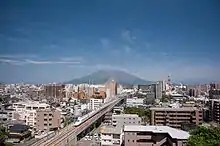 Urban area around the Kagoshima-Chūō Station with Shinkansen (bullet train)
Urban area around the Kagoshima-Chūō Station with Shinkansen (bullet train)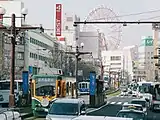 Kajiyachō Tram Stop with its back to the Kagoshima-Chūō Station Building having ferris wheel
Kajiyachō Tram Stop with its back to the Kagoshima-Chūō Station Building having ferris wheel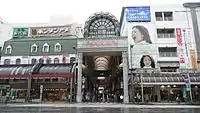 Tenmonkan shopping arcade
Tenmonkan shopping arcade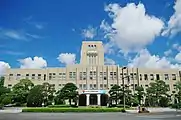 Kagoshima City Hall Main Building
Kagoshima City Hall Main Building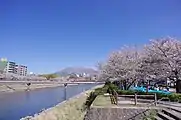 Kotsuki River that runs through Kagoshima City
Kotsuki River that runs through Kagoshima City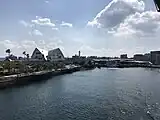 Kagoshima City Aquarium and Sakurajima Ferry Terminal
Kagoshima City Aquarium and Sakurajima Ferry Terminal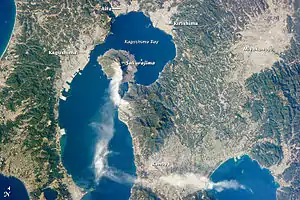 An image taken from the International Space Station showing Kagoshima and its surroundings on January 10, 2013
An image taken from the International Space Station showing Kagoshima and its surroundings on January 10, 2013
Neighboring Municipalities
- Cities: Aira, Hioki, Ibusuki, Minamikyūshū, Minamisatsuma, Satsumasendai, Tarumizu
Climate
Kagoshima has a humid subtropical climate (Köppen climate classification Cfa), possessing the highest year average temperature and winter average temperature in mainland Japan. It is marked by mild, relatively dry winters; warm, humid springs; hot, humid summers; and mild, relatively dry autumns.
| Climate data for Kagoshima (1991−2020 normals, extremes 1883−present) | |||||||||||||
|---|---|---|---|---|---|---|---|---|---|---|---|---|---|
| Month | Jan | Feb | Mar | Apr | May | Jun | Jul | Aug | Sep | Oct | Nov | Dec | Year |
| Record high °C (°F) | 23.9 (75.0) |
24.1 (75.4) |
27.6 (81.7) |
30.2 (86.4) |
31.7 (89.1) |
34.5 (94.1) |
36.6 (97.9) |
37.4 (99.3) |
35.7 (96.3) |
32.4 (90.3) |
29.5 (85.1) |
24.7 (76.5) |
37.4 (99.3) |
| Average high °C (°F) | 13.1 (55.6) |
14.6 (58.3) |
17.5 (63.5) |
21.8 (71.2) |
25.5 (77.9) |
27.5 (81.5) |
31.9 (89.4) |
32.7 (90.9) |
30.2 (86.4) |
25.8 (78.4) |
20.6 (69.1) |
15.3 (59.5) |
23.1 (73.6) |
| Daily mean °C (°F) | 8.7 (47.7) |
9.9 (49.8) |
12.8 (55.0) |
17.1 (62.8) |
21.0 (69.8) |
24.0 (75.2) |
28.1 (82.6) |
28.8 (83.8) |
26.3 (79.3) |
21.6 (70.9) |
16.2 (61.2) |
10.9 (51.6) |
18.8 (65.8) |
| Average low °C (°F) | 4.9 (40.8) |
5.8 (42.4) |
8.7 (47.7) |
12.9 (55.2) |
17.3 (63.1) |
21.3 (70.3) |
25.3 (77.5) |
26.0 (78.8) |
23.2 (73.8) |
18.0 (64.4) |
12.2 (54.0) |
6.9 (44.4) |
15.2 (59.4) |
| Record low °C (°F) | −5.7 (21.7) |
−6.7 (19.9) |
−3.9 (25.0) |
−1.0 (30.2) |
3.9 (39.0) |
9.0 (48.2) |
15.9 (60.6) |
16.5 (61.7) |
9.3 (48.7) |
2.6 (36.7) |
−1.5 (29.3) |
−5.5 (22.1) |
−6.7 (19.9) |
| Average precipitation mm (inches) | 78.3 (3.08) |
112.7 (4.44) |
161.0 (6.34) |
194.9 (7.67) |
205.2 (8.08) |
570.0 (22.44) |
365.1 (14.37) |
224.3 (8.83) |
222.9 (8.78) |
104.6 (4.12) |
102.5 (4.04) |
93.2 (3.67) |
2,434.7 (95.85) |
| Average snowfall cm (inches) | 1 (0.4) |
0 (0) |
0 (0) |
0 (0) |
0 (0) |
0 (0) |
0 (0) |
0 (0) |
0 (0) |
0 (0) |
0 (0) |
1 (0.4) |
2 (0.8) |
| Average precipitation days (≥ 0.5 mm) | 10.2 | 10.2 | 13.2 | 11.1 | 10.7 | 16.9 | 12.8 | 12.2 | 11.3 | 8.0 | 8.9 | 9.9 | 135.4 |
| Average relative humidity (%) | 66 | 65 | 66 | 68 | 71 | 78 | 76 | 74 | 72 | 67 | 68 | 67 | 70 |
| Average dew point °C (°F) | 2 (36) |
4 (39) |
6 (43) |
10 (50) |
15 (59) |
20 (68) |
23 (73) |
24 (75) |
21 (70) |
15 (59) |
10 (50) |
4 (39) |
13 (55) |
| Mean monthly sunshine hours | 132.6 | 139.3 | 163.2 | 175.6 | 178.2 | 109.3 | 185.5 | 206.9 | 176.4 | 184.0 | 157.7 | 143.2 | 1,942.1 |
| Average ultraviolet index | 4 | 5 | 7 | 9 | 10 | 11 | 11 | 11 | 9 | 7 | 4 | 3 | 8 |
| Source 1: Japan Meteorological Agency[9] | |||||||||||||
| Source 2: Weather Atlas (UV),[10] Time and Date[11] | |||||||||||||
| Climate data for Kiire, Kagoshima (1991−2020 normals, extremes 1977−present) | |||||||||||||
|---|---|---|---|---|---|---|---|---|---|---|---|---|---|
| Month | Jan | Feb | Mar | Apr | May | Jun | Jul | Aug | Sep | Oct | Nov | Dec | Year |
| Record high °C (°F) | 23.6 (74.5) |
23.7 (74.7) |
26.7 (80.1) |
29.2 (84.6) |
32.2 (90.0) |
34.5 (94.1) |
36.4 (97.5) |
37.4 (99.3) |
36.5 (97.7) |
33.1 (91.6) |
28.7 (83.7) |
25.5 (77.9) |
37.4 (99.3) |
| Average high °C (°F) | 13.1 (55.6) |
14.5 (58.1) |
17.6 (63.7) |
22.0 (71.6) |
25.7 (78.3) |
27.7 (81.9) |
32.1 (89.8) |
32.9 (91.2) |
30.3 (86.5) |
25.8 (78.4) |
20.5 (68.9) |
15.3 (59.5) |
23.1 (73.6) |
| Daily mean °C (°F) | 8.6 (47.5) |
9.6 (49.3) |
12.5 (54.5) |
16.5 (61.7) |
20.4 (68.7) |
23.6 (74.5) |
27.6 (81.7) |
28.2 (82.8) |
25.5 (77.9) |
20.8 (69.4) |
15.5 (59.9) |
10.5 (50.9) |
18.3 (64.9) |
| Average low °C (°F) | 4.1 (39.4) |
4.9 (40.8) |
7.6 (45.7) |
11.4 (52.5) |
15.6 (60.1) |
20.2 (68.4) |
24.1 (75.4) |
24.6 (76.3) |
21.7 (71.1) |
16.4 (61.5) |
10.8 (51.4) |
6.0 (42.8) |
14.0 (57.1) |
| Record low °C (°F) | −6.3 (20.7) |
−3.6 (25.5) |
−1.4 (29.5) |
2.1 (35.8) |
6.0 (42.8) |
12.1 (53.8) |
17.2 (63.0) |
18.2 (64.8) |
11.5 (52.7) |
5.8 (42.4) |
0.7 (33.3) |
−2.6 (27.3) |
−6.3 (20.7) |
| Average precipitation mm (inches) | 98.9 (3.89) |
136.8 (5.39) |
193.2 (7.61) |
229.9 (9.05) |
231.2 (9.10) |
634.5 (24.98) |
385.2 (15.17) |
228.2 (8.98) |
249.8 (9.83) |
115.0 (4.53) |
126.4 (4.98) |
107.5 (4.23) |
2,765.7 (108.89) |
| Average precipitation days (≥ 1.0 mm) | 10.2 | 10.2 | 12.9 | 10.7 | 10.5 | 16.8 | 12.6 | 11.6 | 11.0 | 7.9 | 8.5 | 9.5 | 132.4 |
| Mean monthly sunshine hours | 123.8 | 133.1 | 161.7 | 183.1 | 182.1 | 107.3 | 192.4 | 220.1 | 173.9 | 181.1 | 151.8 | 132.7 | 1,938.2 |
| Source: Japan Meteorological Agency[12][13] | |||||||||||||
See or edit raw graph data.
Demographics
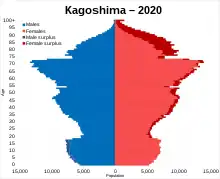
As of 1 January 2020, Kagoshima City has an estimated population of 595,049 and a population density of 1,087 persons per km2. The total area is 547.58 km2 (211 sq mi). According to the April 2014 issue of the Kagoshima Prefectural Summary Archived 2015-01-23 at the Wayback Machine by the Kagoshima Prefecture Department of Planning and Promotion, the population of the prefecture at large was 1,680,319. The city's total area nearly doubled between 2003 and 2005 as a result of five towns: the towns of Kōriyama and Matsumoto (both from Hioki District) the town of Kiire (from Ibusuki District) and the towns of Sakurajima and Yoshida (both from Kagoshima District). All areas were merged into Kagoshima City on 1 November 2004.
|
|
| ||||||||||||||||||||||||||||||||||||||||||||||||
| Kagoshima population statistics[14] | ||||||||||||||||||||||||||||||||||||||||||||||||||
Points of interest
- Ishibashi Park
- Kagoshima City Aquarium
- Kagoshima Botanical Garden
- Museum of the Meiji Restoration
- Sengan-en Garden
Education
Universities and Colleges
Transportation
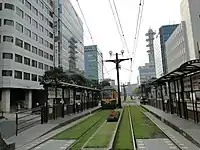
Railways
All lines are operated by Kyushu Railway Company (JR Kyushu)
- Kyushu Shinkansen
- Kagoshima Main Line
- Satsuma-Matsumoto Station – Kami-Ijuin Station – Hiroki Station – Kagoshima-Chuo Station – Kagoshima Station
- Nippo Main Line
- Ryugamizu Station – Kagoshima Station
- Ibusuki Makurazaki Line
- Kagoshima-Chuo Station – Korimoto Station – Minami-Kagoshima Station – Usuki Station – Taniyama Station – Jigenji Station – Sakanoue Station – Goino Station – Hirakawa Station – Sesekushi Station – Nakamyo Station – Kiire Station – Maenohama Station – Nukumi Station
Tramway
- Kagoshima City Transportation Bureau Taniyama Line
- Kagoshima City Transportation Bureau Korimoto Line
Highways
Bus
- Kagoshima City Bus
- Kagoshima Kotsu
- Iwasaki Bus Network
- Nangoku Kotsu
- JR Kyushu bus
- MTA Bus
Ferry/Jetfoil
- Sakurajima Ferry
- A Line (to southern islands)
- Marix Line (to southern islands)
- RKK Line (to Okinawa, cargo only)
- Toppy (to Tanegashima and Yakushima)
- Seahawk (to Koshikijima Islands)
Airport
Kagoshima Airport in Kirishima (35 km (22 miles) NE of Kagoshima)
Sports
Kagoshima was one of the host cities of the official 1998 Women's Volleyball World Championship. Kagoshima is home to Kagoshima United. They play their home games at Kagoshima Kamoike Stadium.
Sister cities and friendship cities
Kagoshima is twinned with:[15]
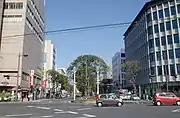 Naples Street in Kagoshima
Naples Street in Kagoshima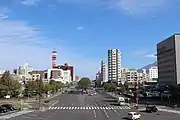 Perth Street in Kagoshima
Perth Street in Kagoshima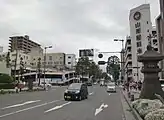 Miami Street in Kagoshima
Miami Street in Kagoshima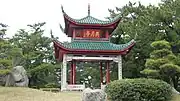 Kyogetsu-Tei in Kagoshima commemorating the friendship city relationship with Changsha
Kyogetsu-Tei in Kagoshima commemorating the friendship city relationship with Changsha
Notable people
- Akitsune Imamura – Japanese seismologist
- Bernardo the Japanese – Japanese Christian convert, disciple of Saint Francis Xavier, and first Japanese to set foot in Europe
- Emi Hashino – Japanese comedian
- Hiroko Ōta – Japanese politician, economic researcher
- Hiroshi Kawauchi – Japanese politician
- Ikki Sawamura – Japanese model, actor, TV presenter
- Izumi Inamori – Japanese actress
- Junichi Miyashita – Japanese swimmer
- Kabayama Sukenori – Japanese samurai military leader and statesman
- Kaneta Kimotsuki – Japanese voice actor (1935–2016)
- Kazuo Inamori – Japanese philanthropist, entrepreneur, founder of Kyocera Corporation and KDDI Corporation, and chairman of Japan Airlines
- Kawasaki Shōzō – Industrialist, founder of the Kawasaki Heavy Industries and K Line groups
- Kōhei Miyauchi – Japanese actor
- Koji Maeda – Japanese football player
- Kiyotaka Kuroda – Japanese politician, second Prime Minister of Japan
- Masao Suenaga – Japanese drifting driver
- Miyo Yoshida – Japanese professional boxer
- Mone Kamishiraishi – Japanese singer and actress
- Morihiko Nakahara – Japanese conductor
- Norihiro Nakajima – Japanese manga artist of Astro Team, etc.
- Ryuji Fujiyama – Japanese football player
- Saigō Takamori – Japanese politician, samurai
- Sakura Miyawaki – Japanese idol singer and actress, member of Le Sserafim
- Saori Sakoda – Japanese volleyball player
- Seiki Kuroda – Japanese artist
- Shinobu Kaitani – Japanese manga artist
- Taisei Okazaki – Japanese DJ & music producer
- Takuya Shiihara – Japanese football player
- Tōgō Heihachirō - Admiral of the Imperial Japanese Navy
- Toru Kamikawa – Japanese football referee
- Toshimichi Ōkubo – Japanese statesman, samurai, and one of the Three Great Nobles who led to the Meiji Restoration
- Yasuhito Endō – Japanese football player
- Yoshito Kajiya – Japanese politician
- Yuki Kashiwagi – Japanese idol singer
- Yuya Hikichi – Japanese football player
References
- "「鹿児島市の生い立ち」 - 鹿児島市公式webサイト (Kagoshima City official website)" (in Japanese). 2020-09-28. Retrieved 2021-09-22.
- "JLect - かごっま・かごんま・かごいま・かごひま【鹿児島】 : kagomma · kagonma · kagoima · kagohima | define meaning". www.jlect.com. Retrieved 2020-10-14.
- A Voyage in Time Glenn Forbes Junshin Immaculate Heart Bulletin No. 52. January, 31st, 2022
- Blacker, Carmen; Cortazzi, Hugh (1 September 1999). Collected Writings of Modern Western Scholars on Japan: Carmen Blacker, Hugh Cortazzi and Ben-Ami Shillony. Psychology Press. ISBN 9781873410967 – via Google Books.
- "Kagoshima", Illustrated London News. 24 January 1914.
- Headquarters, XXI Bomber Command APO 234, "Tactical Mission Report Mission No. 206-209." June 18, 1945.
- 角川日本地名大辞典 46 鹿児島県 p.678
- 角川日本地名大辞典 46 鹿児島県 p.417
- 気象庁 / 平年値(年・月ごとの値). Japan Meteorological Agency. Retrieved May 19, 2021.
- "Kagoshima, Japan – Detailed climate information and monthly weather forecast". Weather Atlas. Retrieved 4 August 2022.
- "Climate & Weather Averages at Kagoshima weather station". Time and Date. Retrieved 4 August 2022.
- 観測史上1~10位の値(年間を通じての値). JMA. Retrieved March 28, 2022.
- 気象庁 / 平年値(年・月ごとの値). JMA. Retrieved March 28, 2022.
- Kagoshima population statistics
- "姉妹・友好・兄弟・協定都市". city.kagoshima.lg.jp (in Japanese). Kagoshima. Retrieved 2020-12-10.
- Amu Plaza Visitors Guide (2006) available in Amu Plaza, Chūō Station, Kagoshima, Japan
- 角川日本地名大辞典 46 鹿児島県. Kadokawa Shoten. 1983-03-08. ISBN 4-04-001460-X.
External links
 Geographic data related to Kagoshima at OpenStreetMap
Geographic data related to Kagoshima at OpenStreetMap- Kagoshima City official website (in Japanese)
- Kagoshima Visitor's Guide from the Kagoshima Internationalization Council

